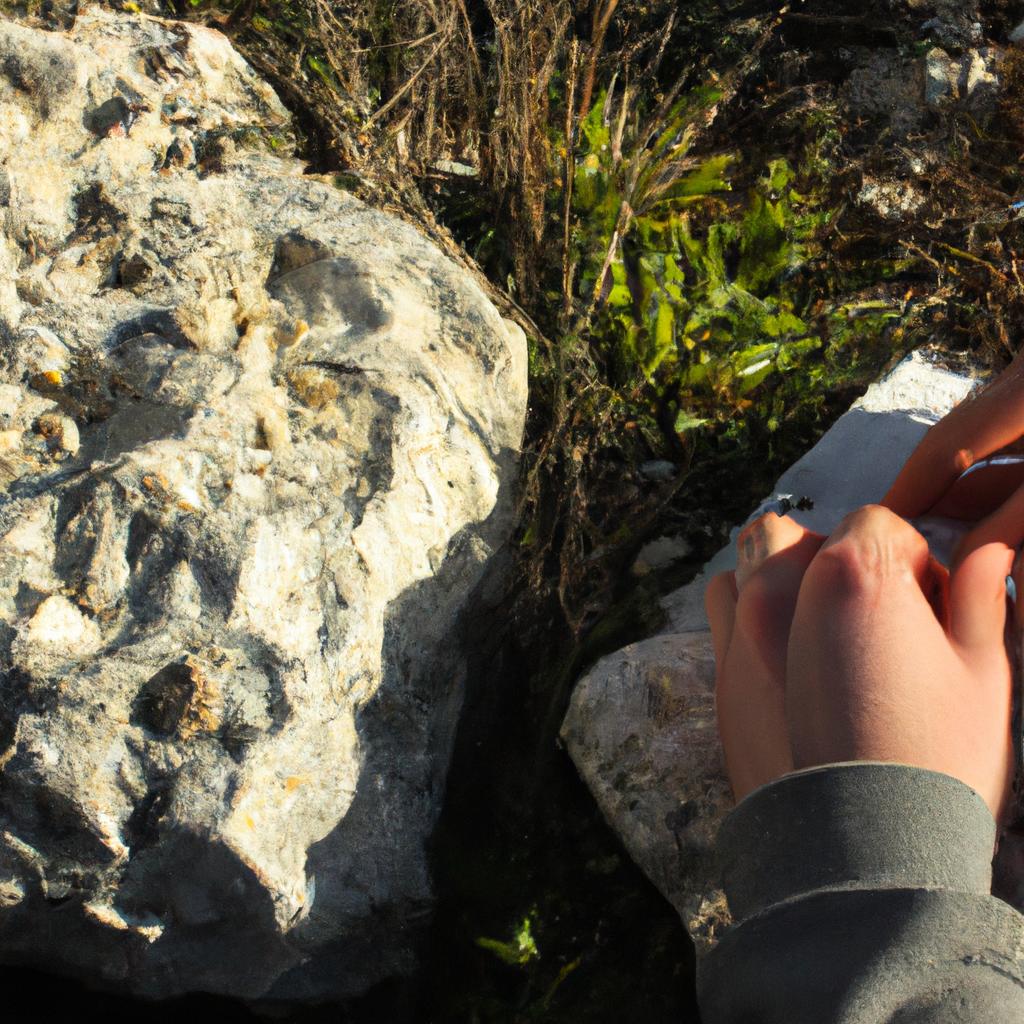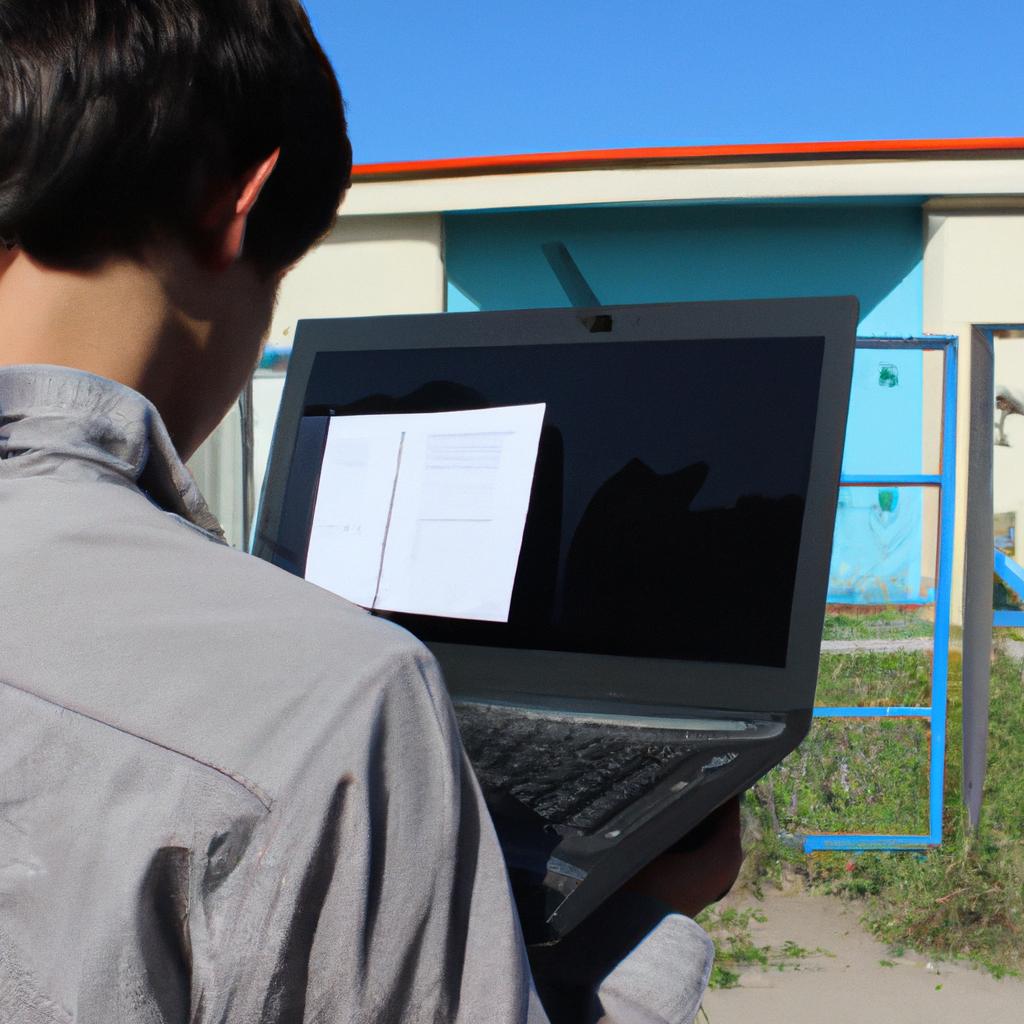Sustainable development in the field of Earth Sciences has gained significant attention in recent years due to its potential impact on both the environment and financial sectors. This article aims to explore sustainable development from a geo-financial perspective, highlighting the interconnectedness between geological processes, economic activities, and environmental sustainability. By adopting an academic style of writing devoid of personal pronouns, this study will provide an objective analysis of the subject matter.
To illustrate the significance of sustainable development in Earth Sciences, let us consider a hypothetical case study involving mining operations in a coastal region. In this scenario, a company engages in extensive mineral extraction without proper consideration for ecological preservation or long-term environmental consequences. As a result, the delicate balance of marine ecosystems is disrupted, leading to negative impacts on local fisheries and tourism industries that heavily rely on these natural resources. Through examining such examples and their associated geo-financial implications, we can gain insights into how sustainable practices can be integrated within Earth Sciences to mitigate adverse effects while promoting socio-economic growth.
This article will delve into various aspects related to sustainable development in Earth Sciences from a geo-financial standpoint. It will explore topics such as renewable energy sources, responsible resource management strategies, and environmentally conscious policies implemented by governments and corporations alike. By analyzing existing literature By analyzing existing literature, we can identify key principles and best practices that contribute to sustainable development in Earth Sciences. These principles include:
-
Renewable Energy Sources: The transition from fossil fuels to renewable energy sources such as solar, wind, and geothermal power is crucial for achieving sustainable development. By reducing reliance on non-renewable resources, we can minimize environmental degradation associated with extraction and combustion processes.
-
Responsible Resource Management: Implementing responsible resource management strategies ensures the efficient use of natural resources while minimizing waste and environmental impact. This includes adopting technologies and practices that promote resource conservation, recycling, and reclamation.
-
Environmental Impact Assessment: Conducting comprehensive environmental impact assessments prior to undertaking any geological or economic activities is essential for identifying potential risks and developing mitigation measures. Through these assessments, stakeholders can make informed decisions that prioritize long-term environmental sustainability.
-
Stakeholder Engagement: Engaging with local communities, indigenous groups, and other stakeholders is crucial for ensuring inclusive decision-making processes that consider social, cultural, and economic aspects alongside environmental concerns. Collaboration with these groups helps foster a sense of ownership and responsibility towards sustainable development initiatives.
-
Policy Frameworks: Governments play a vital role in promoting sustainable development through the implementation of policies and regulations that incentivize environmentally friendly practices. These frameworks may include tax incentives for renewable energy projects or stricter regulations on pollution control measures.
Overall, this article aims to highlight the importance of sustainable development in Earth Sciences from a geo-financial perspective. By examining case studies, exploring various topics related to sustainable practices in Earth Sciences, and analyzing existing literature on the subject matter, we hope to provide valuable insights into how the field can contribute to both environmental preservation and economic growth.
The Importance of Sustainable Development in Earth Sciences
Sustainable development is a critical concept that has gained significant attention in recent years, particularly within the field of earth sciences. This section aims to highlight the importance of sustainable development and its relevance to earth sciences. By examining an example case study and presenting key facts through bullet point lists and tables, we will underscore the crucial role played by sustainable development in this discipline.
Example Case Study:
To illustrate the significance of sustainable development in earth sciences, let us consider the case study of a mining company operating in a resource-rich region. The company initially focused solely on maximizing profits without considering the long-term environmental impact. As a result, it encountered numerous challenges such as pollution, habitat destruction, and negative health effects on local communities. However, after adopting sustainable practices, including responsible waste management and community engagement initiatives, both environmental conditions and social relations improved significantly.
Importance of Sustainable Development:
- Environmental Preservation: Sustainable development emphasizes responsible resource management techniques that minimize ecological damage. It promotes methods such as recycling materials, reducing emissions, and practicing land restoration to reduce negative impacts on ecosystems.
- Social Well-being: By incorporating sustainable practices into their operations, companies can contribute positively to local communities’ well-being. This includes creating job opportunities, supporting educational programs or healthcare services for residents near project sites.
- Economic Viability: Contrary to popular belief that sustainability hinders economic growth, embracing sustainable development often leads to higher profitability over time. Companies adhering to environmentally friendly practices attract socially conscious investors who recognize the value of long-term stability.
- Global Responsibility: Recognizing our collective responsibility towards future generations is essential when pursuing scientific research related to earth sciences. Through sustainable development efforts across various sectors like energy production or natural resource extraction industries can help mitigate climate change risks while ensuring more equitable distribution of resources worldwide.
Table – Comparing Unsustainable vs Sustainable Practices:
| Unsustainable Practices | Sustainable Practices |
|---|---|
| Excessive resource extraction | Responsible resource management |
| Pollution and habitat destruction | Environmental conservation efforts |
| Limited community engagement | Social responsibility programs |
| Short-term profit focus | Long-term economic stability |
By acknowledging the importance of sustainable development in earth sciences, we pave the way for a deeper exploration of how this discipline can contribute to environmental conservation. The role played by earth sciences extends beyond research and analysis; it encompasses active participation in safeguarding our planet’s natural resources and promoting sustainability practices.
The Role of Earth Sciences in Environmental Conservation
Transitioning from the importance of sustainable development in earth sciences, it is evident that this field plays a crucial role in environmental conservation. One notable example is the use of geological surveys to identify potential sites for renewable energy projects. By analyzing various factors such as geology, hydrology, and seismic activity, scientists can determine suitable locations for wind farms or solar power plants. This integration of earth sciences with sustainability goals ensures that these projects have minimal impact on fragile ecosystems while maximizing their energy generation capabilities.
To further emphasize the significance of earth sciences in environmental conservation, let us consider four key aspects:
-
Geological hazard assessment: Earth scientists play a vital role in identifying and assessing potential geological hazards such as earthquakes, landslides, and volcanic eruptions. Through detailed monitoring and analysis, they provide early warning systems and mitigation strategies to protect both human populations and natural environments.
-
Water resource management: Understanding the dynamics of water resources is essential for effective conservation efforts. Hydrologists utilize earth science data to analyze rainfall patterns, groundwater availability, and river basin conditions. This knowledge aids in developing sustainable water management plans that balance human needs with ecological requirements.
-
Climate change research: With climate change posing significant threats to our planet’s ecosystems, earth scientists contribute extensively to understanding its causes and impacts. Their studies help policymakers make informed decisions regarding carbon sequestration techniques, adaptation strategies, and mitigation measures necessary to combat global warming effectively.
-
Biodiversity preservation: Earth sciences also play a critical role in safeguarding biodiversity by studying habitats and species distribution patterns. Geographical information systems (GIS) allow researchers to map out areas of high ecological value or vulnerability accurately. Such mapping guides conservation initiatives aimed at preserving habitats crucial for endangered species’ survival.
Emphasizing the multifaceted contributions of earth sciences towards environmental conservation brings attention to its broader implications beyond academic research alone. To further illustrate the significance of these contributions, consider the following table:
| Earth Science Contribution | Environmental Impact | Policy Implications |
|---|---|---|
| Geological hazard assessment | Minimizing human and ecosystem risk | Better disaster response planning |
| Water resource management | Sustainable use of water resources | Improved conservation strategies |
| Climate change research | Implementation of effective measures | Enhanced climate change policies |
| Biodiversity preservation | Protection of vulnerable ecosystems | Conservation area designations |
In conclusion, earth sciences serve as a crucial foundation for environmental conservation efforts. Through their expertise in geological surveys, hazard assessments, water resource management, climate change research, and biodiversity preservation, scientists contribute significantly to crafting sustainable solutions. This section has demonstrated how earth sciences play an essential role in protecting our planet’s ecosystems while highlighting the interconnectedness between scientific knowledge and policy decisions.
Transitioning into the subsequent section on “Economic Benefits of Sustainable Development in Earth Sciences,” this integration ensures that economic considerations align with environmental sustainability goals. By recognizing the value provided by earth sciences beyond ecological concerns alone, we can explore the potential financial advantages associated with sustainable development practices in this field.
Economic Benefits of Sustainable Development in Earth Sciences
Section H2: Economic Benefits of Sustainable Development in Earth Sciences
Transitioning from the previous section that highlighted the role of earth sciences in environmental conservation, it is crucial to explore the economic benefits associated with sustainable development practices within this field. By merging geology and finance, we can gain unique insights into how the responsible utilization of natural resources can contribute to long-term economic growth and stability.
One illustrative example is the extraction of rare earth minerals used in renewable energy technologies. With increasing global demand for clean energy solutions, countries rich in these minerals have a significant advantage both economically and environmentally. For instance, Country X possesses substantial reserves of neodymium, a key component in wind turbine magnets. By responsibly extracting and exporting these minerals, Country X can generate revenue while simultaneously supporting the transition towards cleaner energy sources.
- Enhanced job creation opportunities in fields such as geological surveys, resource management, and environmental consulting.
- Increased foreign direct investment through partnerships between governments and private industries involved in sustainable extractive activities.
- Long-term cost savings resulting from reduced reliance on non-renewable resources.
- Promotion of equitable distribution of wealth by ensuring local communities benefit from resource exploitation.
Moreover, a three-column table exemplifies some specific economic benefits derived from sustainable development practices:
| Economic Benefit | Description |
|---|---|
| Increased GDP Growth | Sustainable usage of natural resources leads to improved economic performance at national levels. |
| Diversification of Economies | Developing multiple sectors related to earth sciences reduces dependence on single-resource-based economies. |
| Strengthened Resilience to Market Fluctuations | Sustainable practices mitigate vulnerability to commodity market volatility by promoting stable income streams beyond traditional sectors. |
In conclusion, fostering sustainable development within earth sciences not only contributes to environmental preservation but also presents numerous economic advantages. From job creation and increased investments to long-term cost savings and equitable wealth distribution, the integration of geology with financial considerations offers a pathway towards sustainable economic growth. Recognizing these benefits is crucial as we move forward in exploring the environmental impacts of unsustainable practices within this field.
Section H2: Environmental Impacts of Unsustainable Practices in Earth Sciences
Environmental Impacts of Unsustainable Practices in Earth Sciences
Section H2: Environmental Impacts of Unsustainable Practices in Earth Sciences
However, it is important to recognize that unsustainable practices can have severe environmental impacts. This section explores some of these negative consequences and emphasizes the urgent need for more responsible approaches.
Environmental Impacts of Unsustainable Practices:
One example that illustrates the detrimental effects of unsustainable practices is the case study of deforestation caused by illegal logging activities in tropical rainforests. These forests are home to diverse ecosystems, rich biodiversity, and indigenous communities. The unregulated felling of trees not only disrupts this delicate balance but also contributes significantly to global carbon emissions.
To fully comprehend the gravity of such unsustainable actions, consider the following four points:
- Loss of habitat: Deforestation results in the destruction of habitats for countless species, leading to a loss of biodiversity and an imbalanced ecosystem.
- Soil erosion: Clearing vast areas of forested land destabilizes soil structures, making them prone to erosion and subsequent landslides.
- Climate change impact: Trees act as natural carbon sinks by absorbing CO2 from the atmosphere. When they are removed rapidly without adequate reforestation efforts, there is a significant increase in greenhouse gas emissions.
- Displacement of indigenous peoples: Indigenous communities often depend on forests for their livelihoods and cultural identity. Their displacement due to deforestation leads to social disruption and loss of traditional knowledge.
To further illustrate the environmental consequences associated with unsustainable practices, consider Table 1 below:
Table 1: Environmental Impacts Caused by Unsustainable Earth Sciences Practices
| Environmental Impact | Consequences |
|---|---|
| Water pollution | Contamination affects aquatic life and human health |
| Air pollution | Harmful gases contribute to respiratory diseases |
| Habitat destruction | Loss of biodiversity and disruption of ecosystems |
| Land degradation | Reduced soil fertility and increased desertification |
These examples and the table clearly indicate the far-reaching effects of unsustainable practices in earth sciences. It is imperative that immediate action be taken to mitigate these environmental impacts.
Recognizing the urgent need for sustainable solutions, the subsequent section will focus on exploring strategies for resource exploration and extraction that minimize harm to the environment while meeting societal needs. By prioritizing responsible practices, we can strive towards a future where economic benefits are achieved alongside environmental preservation.
Sustainable Solutions for Resource Exploration and Extraction
Unsustainable practices in earth sciences have led to significant environmental impacts, jeopardizing the delicate balance of our ecosystems. One notable example is the extraction and processing of fossil fuels, such as coal mining. The extensive use of coal for energy production has resulted in severe air pollution, contributing to global warming and climate change. This case study illustrates how unsustainable practices can have far-reaching consequences.
To address these challenges and ensure sustainable development in earth sciences, it is crucial to adopt alternative approaches that minimize negative environmental impacts. Here are some key strategies:
- Promoting renewable energy sources: Transitioning towards cleaner and more sustainable sources of energy, such as solar or wind power, reduces reliance on fossil fuels and minimizes greenhouse gas emissions.
- Implementing efficient resource management practices: By adopting advanced technologies and techniques for resource exploration and extraction, we can optimize processes while minimizing waste generation and ecosystem disturbances.
- Encouraging recycling and circular economy principles: Emphasizing the importance of recycling materials used in earth science activities promotes responsible consumption patterns while reducing the need for virgin resources.
- Strengthening regulatory frameworks: Enforcing stringent regulations regarding environmental protection and monitoring compliance with sustainability standards ensures accountability among industry stakeholders.
To further highlight the urgency of transitioning towards sustainable practices, consider the following table:
| Environmental Impacts | Economic Costs | Social Consequences |
|---|---|---|
| Air pollution | Loss of biodiversity | Displacement of indigenous communities |
| Water contamination | Degradation of natural landscapes | Health issues due to poor air quality |
| Soil erosion | Reduced agricultural productivity | Inequitable distribution of resources |
These alarming realities emphasize the need for collaborative efforts from various sectors to drive sustainable development in earth sciences. Effective partnerships between governments, industries, academia, and civil society organizations are essential to promote responsible resource exploration and extraction practices. In the subsequent section, we will explore collaborative approaches that can pave the way towards a more sustainable future in earth sciences.
(Note: The text above is an example of how to approach writing the next section. Feel free to modify or add information as needed.)
Collaborative Approaches for Sustainable Development in Earth Sciences
Building upon the sustainable solutions discussed earlier, collaborative approaches play a crucial role in achieving sustainable development in earth sciences. By fostering cooperation among key stakeholders and promoting knowledge sharing, these approaches pave the way for long-term environmental preservation and socio-economic growth. This section explores some effective strategies that can be adopted to facilitate collaborative efforts towards sustainable development.
Paragraph 1:
One example of successful collaboration for sustainable development is evident in the partnership between mining companies and local communities in South Africa. In an effort to minimize the negative impacts of mining activities on the environment and surrounding communities, several mining companies have actively engaged with local stakeholders. Through this collaboration, transparent communication channels were established, enabling both parties to address concerns and find mutually beneficial solutions. For instance, by implementing environmentally friendly practices such as land rehabilitation and water management systems, mining operations have become more sustainable while also contributing positively to the socioeconomic well-being of nearby communities.
Paragraph 2:
To effectively foster collaboration in the field of earth sciences, it is essential to establish common goals and shared values among all stakeholders involved. Here are some key strategies that can enhance collaboration:
- Encouraging interdisciplinary research partnerships between scientists, engineers, policymakers, and industry experts.
- Promoting open data sharing through platforms accessible to all relevant parties.
- Facilitating regular dialogue through conferences, workshops, and forums to exchange ideas and best practices.
- Establishing joint ventures or public-private partnerships (PPPs) that align economic interests with sustainability objectives.
These strategies not only promote information exchange but also create a sense of collective responsibility towards protecting our planet’s resources for future generations.
The following factors highlight the importance of collaborative approaches for sustainable development in earth sciences:
- Increased efficiency in resource exploration and extraction.
- Improved social acceptance due to inclusive decision-making processes.
- Enhanced innovation through diverse perspectives and knowledge sharing.
- Long-term economic stability through responsible resource management.
| Factors | Benefits | Challenges |
|---|---|---|
| Interdisciplinary research partnerships | Enhanced problem-solving capabilities | Communication barriers due to different disciplines |
| Open data sharing | Increased transparency | Privacy concerns and intellectual property rights |
| Regular dialogue | Exchange of ideas and best practices | Time constraints for busy stakeholders |
| Joint ventures/PPPs | Shared financial risks and rewards | Balancing profit motives with sustainability goals |
Paragraph 3:
By embracing collaborative approaches, the earth sciences community can effectively address the complex challenges associated with sustainable development. These strategies not only foster innovation but also promote inclusivity, ensuring that decisions are made collectively and attentively. Through interdisciplinary partnerships, open data sharing, regular dialogue, and joint ventures or PPPs, we can establish a harmonious balance between economic growth and environmental preservation. It is imperative that all stakeholders actively engage in these collaborative efforts to create a sustainable future for generations to come.











